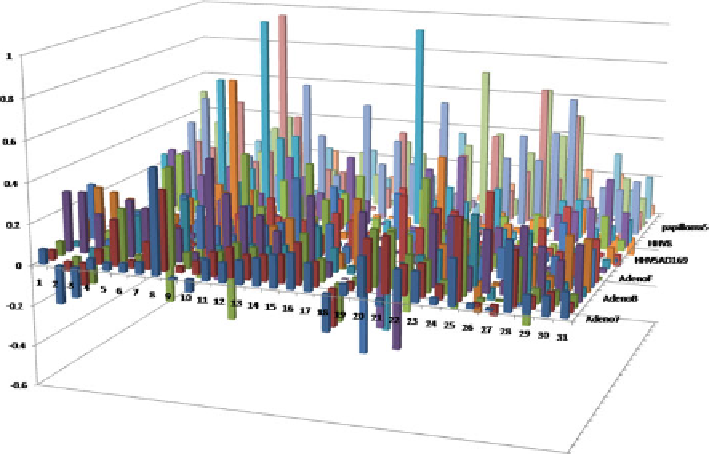Biomedical Engineering Reference
In-Depth Information
Fig. 8
SIR score of early vs. late proteins. The data is shown for 24 viruses of all candidate HLA
alleles (31 alleles). Each column represents the ratio between the difference of the late and early
SIR score to their
sum
virus
the ratio is more than zero, indicating a significant positive difference in the number of presented
epitopes between these groups
([
SIR
(
late
)
−
SIR
(
early
)]
/
[
SIR
(
late
)+
SIR
(
early
)])
.Formost
HLA
/
Thus, quite systematically, late viral proteins express more epitopes than early
ones. Assuming viruses would make all possible efforts to evade detection, one
could assume that viruses would remove all epitopes through mutations. However,
given the large number of epitopes resulting from the MHC polymorphism and the
probable cost of mutations, viruses are probably limited in their attempts to reduce
epitopes. Given these restrictions, our results show that most of the effort is targeted
to early proteins that are probably the most dangerous for the virus.
3.6
The Effect of Protein Density: HBV
Another factor that might determine the strength of immune induced selection on a
viral protein is its copy number. In general, it is more advantageous for the virus to
remove epitopes in proteins with high copy numbers than in proteins with low copy
numbers. The latter would have a low total epitope number even if each protein copy
has a high epitope density. Epitope generation from degraded molecules occurs at
a rate of about 1/10,000 epitope/molecule [
44
]. Thus if a protein has a low copy
number in the cell, it will practically never produce epitopes. The effect of copy
number on immune-induce selection is here tested using the HBV.

Search WWH ::

Custom Search